How to load trailers and distribute weight: Driver’s Education
Putting a heavy load on a trailer may require a bit of math and imagination to get the axle weight right. But running with too much weight at one end or the other could affect the vehicle’s dynamic stability and braking performance.
Tires on lightly loaded axles have less traction than heavily loaded tires. Improper loading could also overload the suspension and would likely result in an overweight ticket if you were caught.
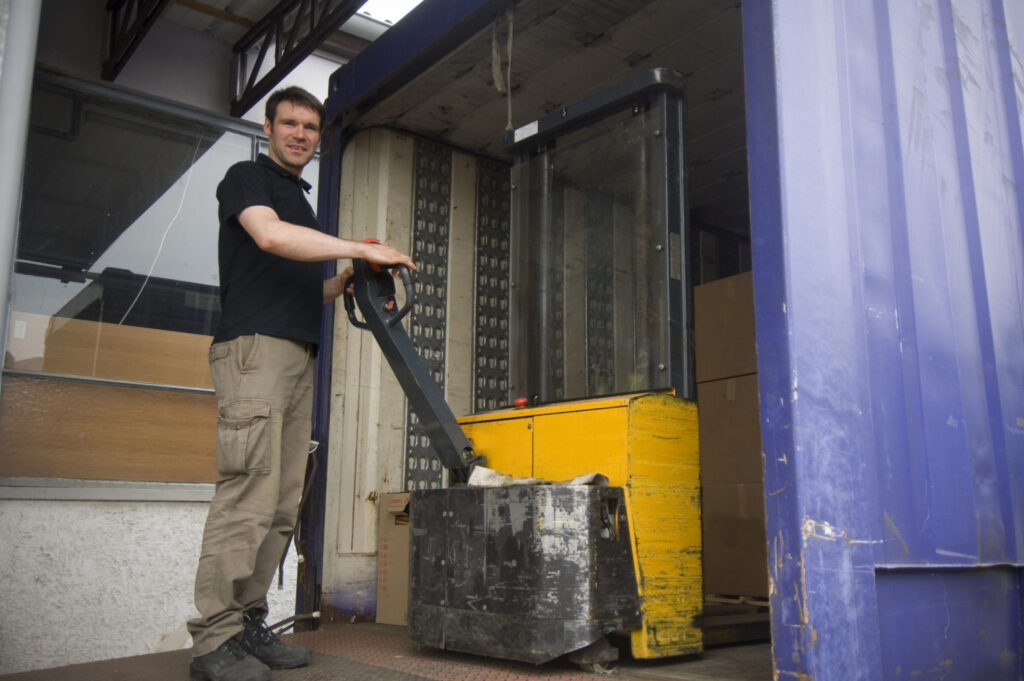
Figuring out how to place your cargo in or on the trailer is part science, part art. It’s easy to work out where to place a load that consists of a number of pallets that have similar weights. With loads of dissimilar cargo, sometimes you have to get creative.
If you’re not already familiar with your truck’s empty axle weight, the calculations start by weighing the truck. Most highway tractors vary from 18,000 to 21,000 lb., and most tandem van trailers weigh around 15,000 lb. Tridems and multi-axle trailers will be heavier, of course, as will refrigerated trailers.
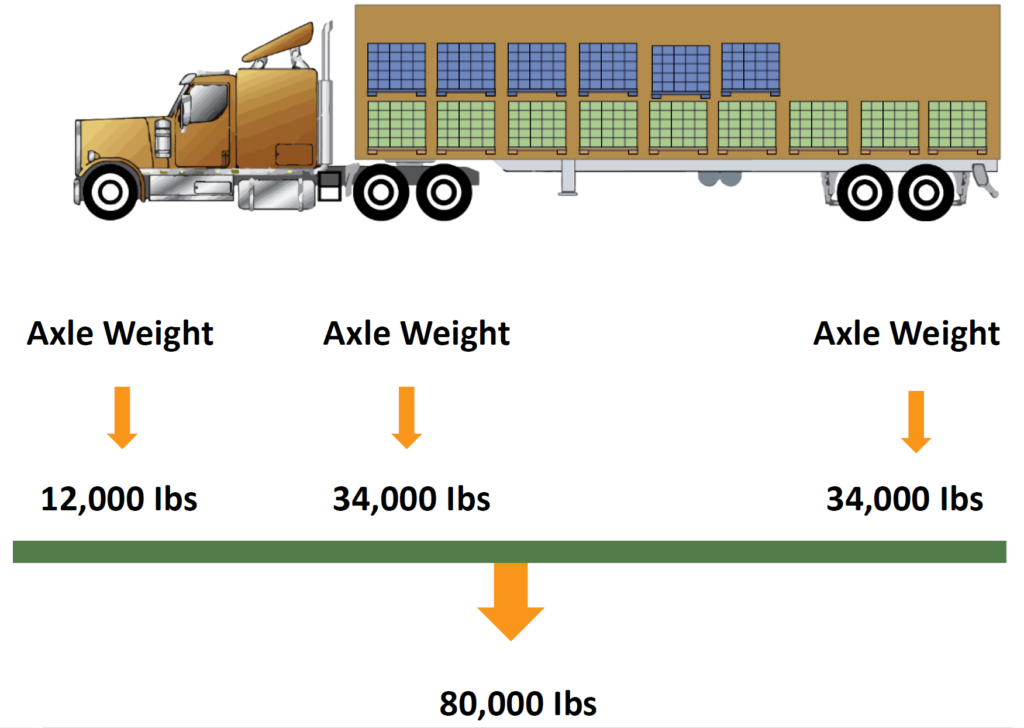
Begin with your truck weight
Slide your fifth wheel and trailer axles into a “normal” configuration, with the kingpin slightly ahead of center of the drive axle, and the trailer axles centered at the 41-foot mark to ensure compliance with the kingpin-to-trailer-axle measurement rules. Ideally the fuel tanks should be full because this will be your worst-case scenario.
We’ll use round numbers for clarity. If the empty weight of a five-axle dry van tractor-trailer is 35,000 lb., the weight might be distributed something like this:
- steer axle: 11,000 lb. (4,990 kg)
- drive axles: 14,000 lb. (6,350 kg)
- trailer axles: 10,000 lb. (4,353 kg)
- tare weight: 35,000 lb. (15,875 kg)
Again, for clarity, we’ll use American axle load limits of 12,000 lb. on the steer axle, and 34,000 lb. on the drive and trailer axles. The numbers will be different (5,500 kg, 17,000 kg and 17,000 kg), but the same thinking applies to Canadian weights.
In this case, your maximum payload could be 1,000 lb. on the steer, 20,000 lb. on the drives, and 24,000 lb. on the trailer axle — or 46,000 lb. for a gross vehicle weight of 80,000 lb.
There are a few things to consider before going any further. Does the weight on the bill of lading or cargo manifest include the weight of the pallets and any associated dunnage? Is the shipper known to be reliable when it comes to reporting cargo weight? Can your truck accommodate the amount of weight you’re asked to pick up?
If you knew your tare weight, you would know in advance if you can put the load on the truck. Once you’re loaded it’s on you to ensure weights are legal or ask the shipper to remove some of the cargo – if you can. Remember, you can remain under gross weight but still be over the limit on an axle group, and that will also earn you a ticket.
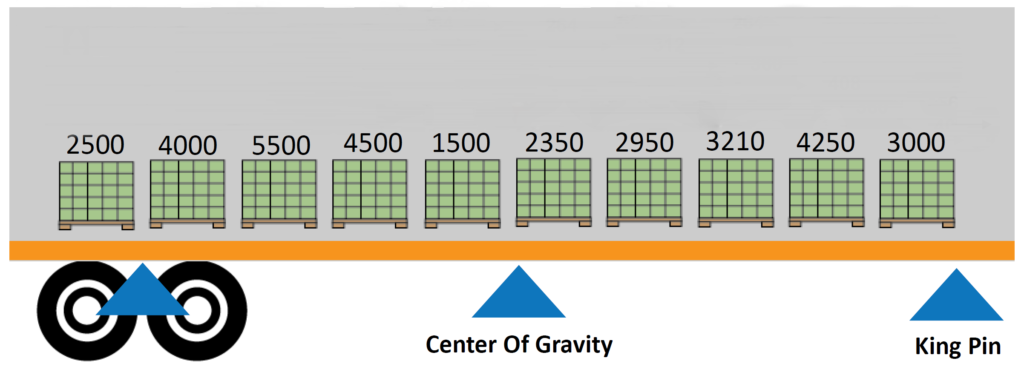
A million possibilities
You can load anywhere from 26 to 30 standard 40×48-inch pallets on a 53-foot trailer — 26 if you load them straight in (48-inch measurements from front to back), or 30 of you turn half the pallets sideways. A full load like that offers no latitude when it comes to where the pallets are placed, so hopefully the load is light enough that it won’t impact your axle weight.
On the other hand, you might have a load of 11 pallets weighing 4,000 lb. each, or worse, a mixed load with pallets of different heights, dimensions and weights.
You also need to consider cargo securement — even inside a van trailer. Roadside inspectors like to peek inside often enough. If they see cargo that’s not secured to prevent forward or lateral movement, they can get pretty excited. Not only must you consider axle weights when placing cargo on the trailer, you have to be sure it won’t shift in transit.
A good starting point is to visualize the pallets on the floor weighing about 800 lb. per foot of floor space from the front to the back. In other words, two 48″ pallets sitting side by side could weigh as much as 3,200 lb., or about 1,600 lb. per pallet. If it were that clean and simple, you could load up to 28 of the 1,600-lb. pallets side by side, and front to back, for a payload of 44,800 lb.
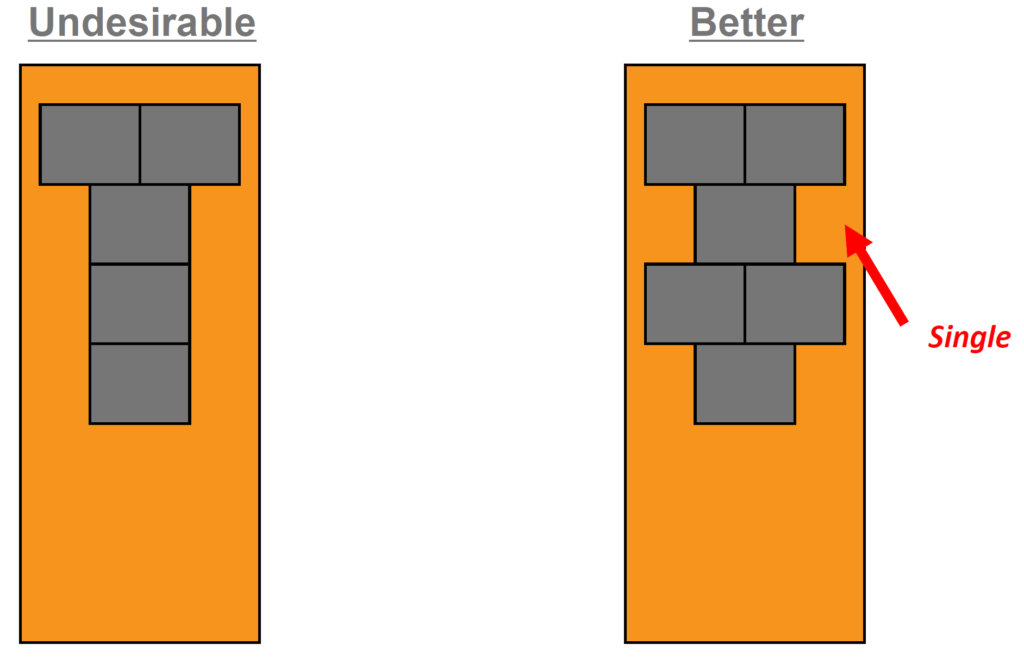
Other considerations
But it’s rarely that simple. Let’s say you had 18 2,500-lb. pallets, leading to a 45,000-lb. payload. Side by side and from nose to tail, you’d have all that weight in the first 36 feet of the trailer. Chances are, you’d be heavy on the drive axles and light on the trailer axles.
But if you staggered the pallets so there were two side by side, followed by one single pallet, and alternated that pattern all the way to the back of the trailer, you would load to about the 48-foot mark – right above the trailer axles. The per-foot load on the floor would be 7,500 lb. over eight feet, and that’s pretty close to the 800 lb. per foot that we’re shooting for.
In this case, it might be beneficial to place two single pallets in a row somewhere close to the front because the drive axles are heavier than the trailer axles when empty. (Picture a layout of pallets that runs 2-1-1-2-1-1-2-1-2 until you reach the back door.)
If the pallets are shrink-wrapped and the loader stuffs them in firmly up against the pallet in front, they probably won’t go anywhere or fall over in transit.
Average that weight
With loads of pallets of various weights, you’ll have to use a calculator to figure out which pallets can go side-by-side to give you the 800 lb. per foot that you want. This may require extending your loading pattern out into eight- or 12-foot segments rather than four-foot (48-inch) segments, and averaging the 800 lb. per foot over eight or 12 feet.
This is where the art of loading comes into play, along with the science. You have to distribute the weight more or less evenly from front to back, but you can skew your figures a bit to load a little heavier in the middle and lighter at the front and rear. This helps distribute the weight a bit more evenly over the length of the trailer.
In such a case, you may be looking at eight-to-12-foot increments. For example, it might mean a 3,000-lb. pallet and 2,000-lb. pallet loaded side by side, followed by a 1,500 pounder and 2,500 pounder, and then a single 2,000 pounder. That you give you 11,000 lb. over 12 feet, which is reasonable.
The voids that result when you load a single pallet are cause for concern. You want to avoid such a situation where you can, but it’s not always possible. Some shippers offer cardboard dunnage or inflatable air bags to help fill voids. Cargo restraining straps are useful, as are restraining or decking bars. Load locks are generally not regarded as suitable cargo restraint devices and may not be accepted by a curious roadside inspector, so don’t depend on them to restrain singled-out pallets. They are definitely not acceptable as forward restraint devices when starting a row with nothing in front.
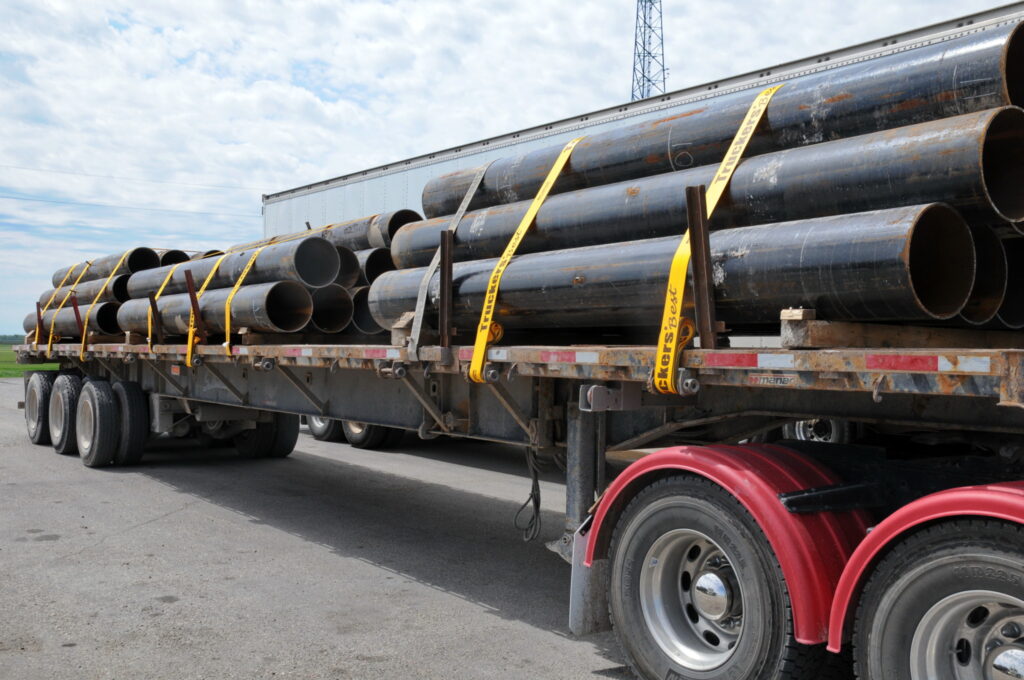
It’s your responsibility
In summary, many shippers have established ways of loading trailers with straight and predictable loads. There’s a bigger challenge with mixed loads or when you’re loading the trailer for multiple drops and the cargo has to be loaded in a specific order.
As the person in charge of the truck, how it’s loaded is ultimately your responsibility. Shippers just want the freight off their dock, so if you’re not comfortable with the way they want to load it, call a supervisor and discuss the situation. It’s better to be a knowledgeable pain in the neck than the one holding the overweight ticket.
Any load that takes you to within 10,000 lb. of your gross weight deserves special attention for load distribution. It’s possible to put 35,000 lb. of freight in 30 feet of trailer, but all the weight would be in the front. That’s not the way it needs to be.
Make notes on how much the truck weights empty, how it’s loaded, and where the weight goes once it’s on the truck. As you learn the way weight is distributed across the axles, you’ll get better at loading evenly from front to back.
– Transportation Warehouse Optimization has produced a worksheet that shows shippers how to load a trailer. There are some useful tips here for drivers, too.
- Driver’s Education is an ongoing series of articles that focuses on things drivers need to know, but may not have learned during entry-level driver training.
Have your say
This is a moderated forum. Comments will no longer be published unless they are accompanied by a first and last name and a verifiable email address. (Today's Trucking will not publish or share the email address.) Profane language and content deemed to be libelous, racist, or threatening in nature will not be published under any circumstances.
Jim, you are a writing genius. You covered every option, spoke to us in an easy tone of voice, and of course made sure everyone could understand.
Thank You!
I need Help with finding a place that could rework a load that I picked up in Laredo TX. They put all the weight on the drive tires, 10,000lbs over I thought the load was lite but I still should’ve scaled it. I’ll own the mistake. I’m in Ardmore OK right now and I need a place that could redistribute the weight in my trailer. Can I get some HELP PLEASE
Hi Jim,
I have question regarding trips with 2 unloads. It seems that after the first unload there would be more weight on the front of the trailer. Still I have not heard that you should rewight your trailer after the first unload. Can you explain to me how this situation works?
When loading a spread axle trailer…is it better to put 36-38k back there and only keep the minimum up front or do like I do and try to keep it fairly even. Using the spread for an easy way to keep your weights legal?
This is the best explanation, scenerio I have found to help, my driver understand gravity, weight distribution, to stay legal. Great layman reading, everyone can understand
they have earned their reputation as a go-to source for liquidation pallets.
they have earned their reputation as a go-to source for liquidation pallets.
I found the best way to be sure is to get your truck weight full of fuel and later when to get a load after it is loaded got to closest scale and be sure of the right distribution, at the scale they allow you two time to scale and adjust your axles and also be familiar with the state regulations on the positioning of your trailer axle.
It work for me.